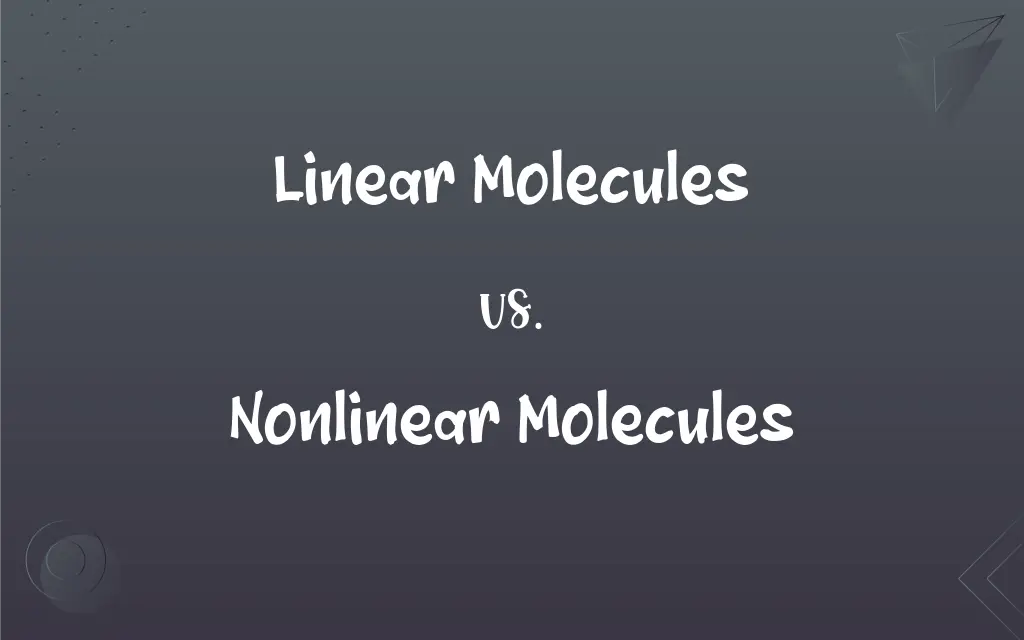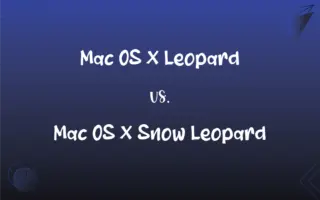Linear Molecules vs. Nonlinear Molecules: What's the Difference?
By Aimie Carlson & Harlon Moss || Published on August 26, 2024
Linear molecules have all atoms in a straight line with 180° bond angles, ideal for diatomic molecules, while nonlinear molecules feature atoms arranged in various shapes, leading to diverse chemical behaviors.

Key Differences
Linear molecules are characterized by their straight-line arrangement of atoms, with bond angles of 180 degrees, common in diatomic molecules like O2 and CO2 where the central atom is bonded to only two other atoms or groups. This geometry is governed by the principles of molecular orbital theory, which predicts the linear arrangement to minimize electron-pair repulsion in molecules with sp or sp hybridization. Nonlinear molecules, on the other hand, exhibit a variety of shapes, such as bent, trigonal planar, tetrahedral, or trigonal bipyramidal, resulting from different hybridizations like sp, sp, or d and the presence of lone pairs of electrons which can alter bond angles and molecular geometry.
The physical and chemical properties of molecules, including their polarity, reactivity, and interaction with light, are significantly influenced by their molecular geometry. Linear molecules can be polar or nonpolar, depending on the electronegativity of the atoms involved and their symmetry. For example, CO2 is nonpolar due to its symmetrical linear shape, despite the polar bonds between carbon and oxygen, because the dipoles cancel each other out. Nonlinear molecules often have distinct dipole moments due to their asymmetrical shape, making them polar, as seen in water (H2O), where the bent shape results in a significant dipole moment.
The molecular geometry not only affects the physical and chemical properties but also the phase of matter a substance is likely to be found in at room temperature and the types of reactions it may undergo. Linear molecules, especially those with nonpolar characteristics, often have lower boiling points due to weaker intermolecular forces like London dispersion forces. In contrast, nonlinear molecules with polar characteristics can engage in stronger intermolecular forces, such as hydrogen bonding in water, leading to higher boiling points.
Understanding the distinction between linear and nonlinear molecules is crucial in fields like spectroscopy, where molecular geometry influences the absorption and emission of electromagnetic radiation, and in materials science, where the structure determines the material's properties and applications. The study of molecular geometry is fundamental in molecular biology, pharmacology, and nanotechnology, where the shape of molecules dictates their interaction with biological systems and their functionality in technological applications.
Comparison Chart
Bond Angles
180°
Varies (less than 180°, dependent on structure)
ADVERTISEMENT
Common Shapes
Straight line
Bent, trigonal planar, tetrahedral, etc.
Hybridization
Typically sp or sp
Sp, sp, sp, d, etc.
Polarity
Can be polar or nonpolar
Often polar due to asymmetrical shape
Boiling Points
Generally lower (if nonpolar)
Generally higher (if polar)
Examples
CO2, O2
H2O, NH3
ADVERTISEMENT
Linear Molecules and Nonlinear Molecules Definitions
Linear Molecules
Linear geometry affects spectroscopy.
The linear shape of CO2 influences its vibrational modes.
Nonlinear Molecules
They often have polar characteristics.
NH3 is polar due to its trigonal pyramidal shape.
Linear Molecules
Linear molecules can be symmetrical.
N2 is nonpolar due to its symmetrical linear shape.
Nonlinear Molecules
Their shape is crucial in biological interactions.
The nonlinear structure of enzymes determines their specificity.
Linear Molecules
Linear molecules have all atoms aligned.
CO2 is a linear molecule with O=C=O structure.
Nonlinear Molecules
Nonlinear structures can form due to lone pairs.
The two lone pairs on O in H2O create a bent shape.
Linear Molecules
They can exhibit sp or sp hybridization.
BeCl2 is linear due to sp hybridization.
Nonlinear Molecules
Nonlinear molecules have varied shapes.
H2O's bent shape makes it a classic nonlinear molecule.
Linear Molecules
They may have lower boiling points.
O2 is a gas at room temperature due to weak dispersion forces.
Nonlinear Molecules
They may have higher boiling points.
Water's high boiling point is due to hydrogen bonding.
FAQs
Are linear molecules always small?
No, linear molecules can range from very small, like CO2, to very large, such as long-chain hydrocarbons.
Give an example of a linear molecule.
Carbon dioxide (CO2) is a classic example, with oxygen atoms bonded on either side of a carbon atom in a straight line.
What is a linear molecule?
A linear molecule has all its atoms arranged in a straight line, with bond angles of 180 degrees.
How are linear molecules identified?
They are identified by their straight-chain structure without any branches or bends.
What is a nonlinear molecule?
A nonlinear molecule is one where the atoms do not form a straight line, resulting in various bond angles that are not 180 degrees.
How do linear and nonlinear molecules differ in polarity?
Linear molecules can be polar or nonpolar, depending on the electronegativity of the atoms involved. Nonlinear molecules are often polar due to their asymmetrical shape.
How are bond angles determined in nonlinear molecules?
Bond angles in nonlinear molecules are determined by the electron-pair repulsion theory, also known as VSEPR theory.
What causes the nonlinearity in molecules?
Nonlinearity can result from the presence of lone pairs of electrons, multiple bonding sites, or the molecular geometry itself.
Can nonlinear molecules be symmetrical?
Yes, some nonlinear molecules are symmetrical, but their symmetry doesn't result in a linear shape.
Do linear molecules have higher symmetry than nonlinear ones?
Yes, linear molecules generally have higher symmetry due to their uniform shape.
What types of bonds do linear molecules have?
They can have single, double, or triple covalent bonds, as long as the atomic arrangement remains straight.
Are linear molecules more stable than nonlinear ones?
Stability depends on the specific context (e.g., types of bonds, external conditions) rather than merely on linearity.
Give an example of a nonlinear molecule.
Water (H2O) is a well-known nonlinear molecule, with a bent structure due to the two lone pairs of electrons on the oxygen atom.
Can the molecular formula predict linearity?
The molecular formula gives the number of atoms but not the arrangement; hence, it cannot always predict linearity.
How does the presence of lone pairs affect molecular linearity?
Lone pairs can cause repulsion that affects bond angles, often leading to nonlinearity in molecules.
Are all diatomic molecules linear?
Yes, all diatomic molecules are linear because they consist of only two atoms, which naturally form a straight line.
How do linear and nonlinear molecules behave differently in physical states?
Their behavior can differ in aspects like boiling and melting points, where linear molecules might have different intermolecular forces affecting these properties compared to nonlinear molecules.
What distinguishes linear from nonlinear molecules in terms of molecular shape?
Linear molecules have a straight-line shape, while nonlinear molecules have a bent, angular, or other non-straight shape.
How does the functionality of molecules relate to their linearity?
The functionality, such as reactivity and physical properties, can be influenced by molecular shape; linear molecules might have different properties than nonlinear ones.
Can molecules with triple bonds be nonlinear?
Typically, molecules with a central atom and triple bonds are linear, but overall molecular nonlinearity can occur with more complex structures.
About Author
Written by
Aimie CarlsonAimie Carlson, holding a master's degree in English literature, is a fervent English language enthusiast. She lends her writing talents to Difference Wiki, a prominent website that specializes in comparisons, offering readers insightful analyses that both captivate and inform.
Co-written by
Harlon MossHarlon is a seasoned quality moderator and accomplished content writer for Difference Wiki. An alumnus of the prestigious University of California, he earned his degree in Computer Science. Leveraging his academic background, Harlon brings a meticulous and informed perspective to his work, ensuring content accuracy and excellence.





































































